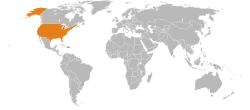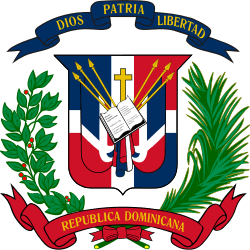Dominican Republic–United States relations
 | |
Dominican Republic |
United States |
|---|---|
Dominican Republic – United States relations are bilateral relations between the Dominican Republic and the United States.
According to the 2012 U.S. Global Leadership Report, 57% of Dominicans approved of U.S. leadership, with 8% disapproving and 35% uncertain, the third highest rating for any surveyed country in the Americas.[1]
Overview
The country's standing as the largest Caribbean economy, second-largest country in terms of population and land mass, with large bilateral trade with the United States, and its proximity to the United States and other smaller Caribbean nations make the Dominican Republic an important partner in hemispheric affairs. The Embassy estimates that 100,000 U.S. citizens live in the Dominican Republic; many of whom are dual nationals. An important element of the relationship between the two countries is the fact that more than 1 million individuals of Dominican origin reside in the United States, most of them in the metropolitan Northeast and some in Florida.
The U.S. occupied the Dominican Republic from 1916 until 1924 and intervened on behalf of the Dominican government during the Dominican Civil War.
The Dominican government has been supportive of many U.S. initiatives in the United Nations and related agencies. The two governments cooperate in the fight against the traffic in illegal substances. The Dominican Republic has worked closely with U.S. law enforcement officials on issues such as the extradition of fugitives and measures to hinder illegal migration.
The United States supports the Leonel Fernández administration's efforts to improve Dominican competitiveness, to attract foreign private investment, to fight corruption, and to modernize the tax system. Bilateral trade is important to both countries. U.S. firms, mostly manufacturers of apparel, footwear, and light electronics, as well as U.S. energy companies, account for much of the foreign private investment in the Dominican Republic.
Exports from the United States, including those from Puerto Rico and the U.S. Virgin Islands, to the Dominican Republic in 2005 totaled US$5.3 billion, up 11% from the previous year. The Dominican Republic exported $4.5 billion to the United States in 2006, equaling some 75% of its export revenues. The Dominican Republic is the 47th-largest commercial partner of the U.S. The U.S. Embassy works closely with U.S. business firms and Dominican trade groups, both of which can take advantage of the new opportunities in this growing market. At the same time, the Embassy is working with the Dominican government to resolve ongoing commercial and investment disputes.
The Embassy counsels U.S. firms through its Country Commercial Guide and informally via meetings with business persons planning to invest or already investing in the Dominican Republic. This is a challenging business environment for U.S. firms, especially for medium to smaller sized businesses.
The U.S. Agency for International Development (USAID) mission is focused on improving access of underserved populations to quality health care and combating HIV/AIDS and tuberculosis (TB), promoting economic growth through policy reform, support for CAFTA-DR implementation, and technical assistance to small producers and tourism groups; environmental protection and policy reform initiatives; improved access to quality primary, public education and assistance to at-risk youth; a model rural electrification program; and improving participation in democratic processes, while strengthening the judiciary and combating corruption across all sectors.
History
Dominicans constituted one of the many diverse units which fought alongside Spanish forces under Bernardo de Gálvez during the Gulf Coast campaign of the American Revolution.[2][3]
In 1869, President Ulysses S. Grant ordered U.S. Marines to the island for the first time. Pirates operating from Haiti had been raiding U.S. commercial shipping in the Caribbean, and Grant directed the Marines to stop them at their source. Following the virtual takeover of the island, the Dominican president offered to sell the country to the United States for $100,000 in cash and $50,000 in armament credits). Although President Grant supported the arrangement, the Senate, under the leadership of abolitionist Charles Sumner, failed to pass the annexation legislation.[4]
On 5 May 1916, President Woodrow Wilson ordered the Marines back to Santo Domingo following twenty-eight revolutions in fifty years.[4][5] They stayed for eight years to manage the country's finances and preserve the peace, and the U.S. Navy Department virtually ran the entire country. American troops left in 1924 after the election of General Horacio Vasquez.[4]
In 1927, Rafael Trujillo became the chief of the national police and principal adviser to President Horacio Vasquez. The following year Trujillo formed the Dominican Secret Police, which he headed, and converted the national police into an autonomous paramilitary force under his direct command. In 1930, he marshaled his supporters and his forces and successfully ran for office in a typical Dominican election where power and coercion replaced free choice and accurate ballot counting.[4]
Trujillo ruled the Dominican Republic for thirty years as a ruthless dictator and became one of the most graphic examples of a Latin American caudillo ever to hold office.[4] During his long regime the country had no independent legislature, judiciary, or political opposition. He used the secret police extensively to eliminate political opposition and to prevent several coup attempts during and after World War II. The secret police allegedly murdered more than 500,000 people during the Trujillo era, including some 37,000 Haitians.[4]
During this long period of oppression and death, the Trujillo government extended its policy of state terrorism beyond national borders. Notorious examples of Trujillo’s reach abroad are the unsuccessful assassination attempt in Caracas against Venezuelan President Rómulo Betancourt (1960), the abduction and subsequent disappearance in New York City of the Spaniard Jesús Galíndez (1956), the murder of writer José Almoina in Mexico, also a Spaniard, and crimes committed against Cubans, Costa Ricans, Nicaraguans, Puerto Ricans, as well as United States citizens.[6]
In June 1960 the Organization of American States' Human Rights Commission issued a scathing report on violations in the Dominican Republic. Supported by the U.S. State Department, the commission accused Trujillo of flagrant and numerous violations of human rights against the citizens of the Dominican Republic. Trujillo retaliated against the chief proponent of the report, Venezuelan President Romulo Betancourt, by actively supporting an assassination attempt. The plot failed and Trujillo's involvement in the conspiracy became public in a report by the OAS Council's (the organization's general assembly) investigating committee. Composed of representatives from the United States, Argentina, Mexico, Panama, and Uruguay, the committee verified Dominican complicity and placed responsibility on "high officials" within the government.
Responding to a Venezuelan call for collective action, on 20 August 1960 the OAS Council passed a resolution invoking diplomatic and economic sanctions against the Trujillo government. The resolution, passed fourteen to one (the Dominican Republic dissented while Brazil, Argentina, Guatemala, Haiti, Paraguay, and Uruguay abstained), marked the first time that the organization had taken such actions against a member nation.[4] As a show of support, President Dwight D. Eisenhower suspended all economic and diplomatic relations with the Dominican Republic.[4]
Trujillo was assassinated on 31 May 1961 by a small band of conspirators led by Antonio de la Maza and Antonio Imbert Barrera. The coup attempt that followed failed to seize power and all of the conspirators except Imbert were found and executed by Ramfis Trujillo, the dictator's son, who remained in de facto control of the government for the next six months through his position as commander of the armed forces.[4] Trujillo's brothers, Hector Bienvenido and Jose Arismendi Trujillo, returned to the country and began immediately to plot against President Balaguer.
On 18 November 1961, as a planned coup became more evident, U.S. Secretary of State Dean Rusk issued a warning that the United States would not "remain idle" if the Trujillos attempted to "reassert dictatorial domination" over the Dominican Republic. Following this warning, and the arrival of a fourteen-vessel U.S. naval task force within sight of Santo Domingo, Ramfis and his uncles fled the country on 19 November with $200 million from the Dominican treasury.[4]
In 1963 Juan Bosch and his moderately reformist Dominican Revolutionary Party took power; he was the first directly elected democratic and progressive president in the country’s history. However, Bosch earned the enmity of the country’s oligarchy and key U.S. officials, and after seven hectic months he was overthrown. In 1965 a democratic revolution was sparked to oppose the country’s return to oligarchical rule, but the United States, fearing the installation of a communist regime (as had happened in Cuba the previous decade), again occupied the country in 1965–66 and snuffed out the revolt.
United States diplomatic mission
- Ambassador--James "Wally" Brewster, Jr.
- Deputy Chief of Mission—Christopher Lambert
- USAID Mission Director—James Watson, Acting
- Consul General—William Weissman
- Economic and Political Counselor—Alexander Marguiles
- Public Affairs Adviser—Todd Philip Haskell
- Commercial Counselor (DOC/FCS)--Robert O. Jones
- Defense Attaché—Lt. Col. David M. O'Connell (U.S. Marine Corps)
The U.S. Embassy is located in Santo Domingo.
Dominican Republic diplomatic mission
- Ambassador--José Tomás Pérez
See also
External links
References
![]()
- ↑ U.S. Global Leadership Project Report - 2012 Gallup
- ↑ Latino Chronology: Chronologies of the American Mosaic.
- ↑ Spain and the Independence of the United States: An Intrinsic Gift.
- 1 2 3 4 5 6 7 8 9 10 Greenberg, Lawrence (November 1986). "US Army Unilateral and Coalition Operations in the 1965 Dominican Republic Intervention" (PDF). US Army Center of Military History.

- ↑ Ayres (2008). A Military Miscellany.
- ↑ "Documentary Heritage on the Resistance and Struggle for Human Rights in the Dominican Republic, 1930-1961" (PDF).
